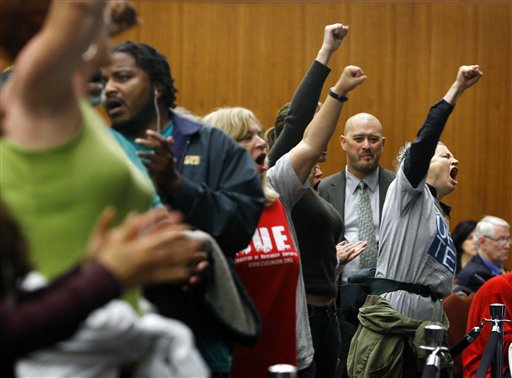SAN FRANCISCO (AP) — It isn’t just tuition increases that are driving up the cost of college. Around the country, deep budget cuts are forcing colleges to lay off instructors and eliminate some classes, making it harder for students to get into the courses they need to earn their degree.
The likely result: more time in college.
And while that may sound agreeable to nostalgic alumni, to students like Michael Redoglia, time is money.
Early this semester at San Francisco State University, Redoglia unsuccessfully crashed 26 different classes, hoping to find space that would move him closer to a hospitality management degree. Outside some classrooms, wait-listed students took turns standing closest to the door so they could hear the lecture and not fall too far behind should they get in.
Redoglia, a fourth-year student, is now enrolled in just two courses. He could lose financial aid, and his plan to finish his degree in 4½ years is up in smoke.
“This semester has put me back another full year,” said Redoglia, adding that the delay is “killing me financially.”
Policymakers right up to President Barack Obama have been calling on public colleges to move students through more efficiently, and some have been doing so. But experts say any recent progress is threatened by unprecedented state budget cuts that have trimmed course offerings.
“They will not graduate on time. I hope they will graduate at all,” said David Baggins, who as chairman of political science at Cal State University-East Bay has been bombarded with requests for spots in already packed classes.
“Before,” Baggins said, “there was always a way to help the student who really needed help.” This year, “all I can do is say no.”
Some students struggle for places in the core entry-level classes such as composition and math because the part-time instructors who typically teach those courses are the first to be laid off in tough times. Other students are shut out of crowded core courses in their majors by upperclassmen. Some upperclassmen face an even tougher road: The upper-level classes they need have been cut entirely because they aren’t popular enough.
A federal study of 1999-2000 graduates found it takes students roughly 4.5 years on average to earn a bachelor’s degree. About two-thirds of traditional-age college students who finished got through within five. A study of 2009 graduates is not yet complete.
In the 450,000-student California State system — the nation’s largest public university system — the average is longer, in part because of large numbers of low-income, part-time and transfer students. A 2007 study of students who entered 12 years earlier found they took an average of 5.7 years. Officials say that number was probably falling slightly before the current cuts hit.
To help students get the courses they need to graduate, the University of North Carolina-Chapel Hill raised enrollment caps on some English and foreign language classes from 19 to 24. The University of Kansas also increased some class sizes — but offered fewer sections of a big introductory chemistry course. Both schools insist most students who truly needed a class eventually got in.
But at Central Oregon Community College in Bend, Ore., where enrollment has grown over 60 percent in the past three years, nearly 400 students don’t have even one of the courses they requested. Many of the school’s worker retraining programs consist of classes that are supposed to be taken in sequence, so students who can’t get slots could be stuck until next fall.
The 23-campus Cal State system has raised tuition more than 30 percent, increased class sizes, laid off hundreds of teachers and cut thousands of class sections in response to a 20 percent state budget cut.
Around the country, the belt-tightening has made the usual begging and pleading with professors to make more space especially urgent.
“Some of them are more open — they understand you’re trying to get into classes you need,” said Haley Sink, a sophomore at Virginia Tech from Kernersville, N.C., who failed to get into several classes this year and hopes to avoid a fifth year of out-of-state tuition. “Others say, ‘I absolutely cannot handle more students.'”
Money isn’t necessarily the only problem, some experts argue. Patrick Callan, president of the National Center for Public Policy and Higher Education, said universities focus too much on prestigious but unessential graduate programs at the expense of the undergraduate basics. Others want professors pushed harder to teach essential courses instead of their own boutique interests — and students to accept more unpopular, early-morning slots.
But some students say they are out of choices.
Sherrie Canedo, a fifth-year senior at Cal State-East Bay, was recently told she could finish her ethnic studies degree through independent study because most of the courses she needs were eliminated.
“I don’t feel that’s an acceptable way to learn,” said Canedo, who is working two jobs and trying to string together enough financial aid to finish her education. “I’m paying to be taught in a classroom.”
News researcher Rhonda Shafner in New York City contributed to this report. Justin Pope reported from Raleigh, N.C.







